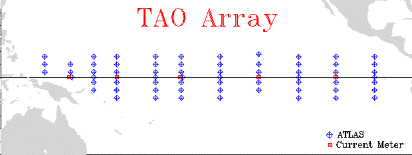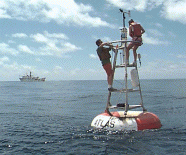PMEL Programs and Plans
Accomplishments in FY 99 and Plans for FY 00
Refereed TAO Publications
Other TAO Publications
 
Figures (a) TAO array, consisting of approximately 70 deep
ocean moorings, provides high quality, in-situ, real-time data for
short-term climate studies relating to El Niño, and
(b) NOAA's newly commisioned research vessel Ka'imimoana is dedicated
to servicing the TAO buoys.
Tropical Atmosphere-Oceans Program
"Observing systems have been fundamental in alerting the world
to the onset of the latest El Niño. The array of moored buoys
across the Pacific Ocean...has been an invaluable source of
data for monitoring and modeling the event."
G. O. P. Obasi, Secretary General, WMO
World Climate News, June 1998
The Tropical Atmosphere-Ocean (TAO) Array consists of approximately
70 deep-ocean moorings spanning the equatorial Pacific Ocean
between 8N and 8S from 95W to 137E. The purpose of the array is
to provide high quality, in-situ, real-time data in the equatorial
Pacific Ocean for short-term climate studies, most notably those
relating to the El Niño/Southern Oscillation (ENSO) phenomenon. The
moored measurements consist primarily of surface winds, sea surface
temperature, upper ocean temperature and currents, air temperature,
and relative humidity. Data are telemetered in real time via Service
Argos. A subset of these data is placed on the Global Telecommunications
System (GTS) for distribution to operational centers where they are
assimilated into weather and climate forecast models. The NOAA Ship
Ka'imimoana, commissioned in 1996, is dedicated to servicing the array
between 95W and 165E. The array is part of the operational ENSO
Observing System, supported by NOAA's Office of Oceanic and Atmospheric
Research.
Accomplishments in FY 99
Work at PMEL during the past year has included description and
diagnosis of physical mechanisms responsible for the 1997-98 El Niño,
which was among the strongest on record. This work has highlighted the
importance of intraseasonal atmospheric forcing in affecting the
amplitude and onset of the event. A cover story in Science magazine
described the interplay between the physics, biology, and chemistry of
the tropical Pacific during the 1997-98 El Niño using data from the TAO
array, NOAA ships, and from spaceborne sensors. Other studies have examined
the upper ocean mass, heat, momentum, and fresh water balances in the
upper equatorial Pacific Ocean using TAO and related data sets. These
studies have illustrated the complex mix of mechanisms that give
rise to observed variability on a wide range of time scales (diurnal,
intraseasonal, seasonal, and interannual) of relevance to climate.
In FY 99, refinements of the Next Generation ATLAS moorings continued,
and the number of sites in the array instrumented with this new
technology increased from 11 to 24. Moored bio-optical, nutrient and chemical
sensors were maintained at a few sites in collaboration with the NOAA Ocean
Atmosphere Carbon Exchange Studies (OACES) Program and the NASA SeaWifs
(ocean color) satellite program. The TAO project also continued a short
wave radiation measurement program in the western Pacific in
collaboration with the US Department of Energy/Atmospheric Radiation Measurements
(DOE/ARM) program, and an in situ rainfall and surface salinity
measurement program with the NASA Tropical Rainfall Measuring Mission (TRMM)
program. The TAO project also participated in two special field studies in FY 99,
the DOE/ARM NAURU99 Experiment and the NASA/TRMM KWAJEX Experiment.
Surface salinity measurements were maintained between 156E and the date
line, supported in part by the French Institut de Recherche pour le
Developement. Implementation of the Pilot Research Moored Array in the
Tropical Atlantic (PIRATA) continued in collaboration with Brazil and
France, with the array expanding from five to eleven sites. Two high
latitude ATLAS moorings, transmitting via GOES, were successfully
deployed in the North Pacific at Ocean Station PAPA (50N, 145W) and Station MOMMA
(35N, 165W) as part of the National Ocean Partnership Program.
In all, TAO used 434 sea days on 7 ships from 5 countries to deploy 93
moorings. TAO personnel spent 932 person days at sea on cruises during
this time.
Tropical Atmosphere-Oceans Program
Plans for FY 00
-
Maintain the array as part of the ENSO Observing System in
support of NOAA's Seasonal to Interannual Climate Prediction Program (SICPP),
GOOS, GCOS, and CLIVAR.
-
Transition the TAO array to the TAO/TRITON array, with TRITON
moorings maintained by the Japan Science and Technology Center (JAMSTEC) west of
165E.
-
Continue transition to Next Generation ATLAS moorings east of
165E; upgrade ATLAS moorings for real-time velocity, longwave radiation, and
barometric pressure.
-
Continue moored radiation, rainfall, bio-optical, chemical, and
salinity measurements as part of collaborative studies.
-
Expand and enhance the array in the eastern tropical Pacific
along 95W in support of NOAA's Pan American Climate Studies (PACS)/Eastern
Pacific Investigation of Climate Processes (EPIC).
-
Conduct a special month-long land-based intercomparison study
between ATLAS, TRITON, and WHOI/IMET moorings at Woods Hole Oceanographic
Institute.
-
Complete the PIRATA array in the tropical Atlantic (12 sites);
expand and enhance PIRATA with new moorings in "hurricane alley" (10-20N).
-
Conclude NOPP field program with recovery of moorings at
Stations PAPA and MOMMA.
-
Maintain and enhance on-line access to TAO data sets.
-
Continue scientific analyses of TAO, PIRATA, and NOPP data, in
conjunction with shipboard, satellite, historical, and model based
data sets.
|

